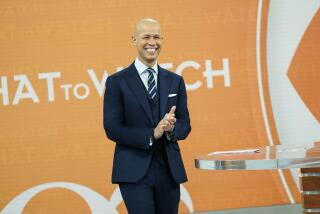A hard shift
NEW YORK — From the vintage globe projected behind the anchor desk to the Cronkite-era producers mixing it up at story meetings to the no-frills reports that fill 21 minutes and 16 seconds each weeknight, the “CBS Evening News” has made a determined effort to bring newsy back.
A shift that began in the latter months of Katie Couric’s five-year run has accelerated and taken on a new fervor in the last nine months since the ascension of Scott Pelley to the anchor’s chair.
When Pelley took the seat once occupied by Walter Cronkite last June, it represented a return to form at CBS News -- giving perhaps the network’s most visible platform not to a celebrity host but to a longtime reporter best known for his work on “60 Minutes” and for dozens of forays to Iraq, Afghanistan and other world hot spots.
In a recent interview in his office, where he kept Beethoven’s Seventh at a low rumble, Pelley gave hints of a healthy competitive streak, as when he noted that his CBS team was alone among the networks in traveling to Afghanistan to cover the 10th anniversary of the war there
“There are 150,000 American troops fighting every day in Afghanistan, and we are the only broadcast there?” he said. “That was astounding to me. Astounding.”
The old-school approach offers at least some promise that the nightly newscast, long mired in third place among the three networks, might finally claw its way out of the cellar. The “CBS Evening News With Scott Pelley” is the only one of the three network nightly news shows to score a small year-to-year increase in three ratings categories for the season that began in September. In one recent week, it finished second -- behind NBC but ahead of ABC -- among the 25-to-54 age demographic prized by advertisers. That hadn’t happened since 2006.
Still, at roughly 6.8 million nightly viewers, CBS’ show remains more than 1 million behind the “World News With Diane Sawyer” at ABC and nearly 3 million behind NBC’s “Nightly News With Brian Williams.”
The media no longer cling to the results of the nightly news wars the way they used to. The public’s appetite clearly has slackened for a set half-hour of news, at a fixed time early each evening. Viewers now scatter to myriad cable TV and Internet alternatives. Roughly 24 million Americans watch the marquee evening news shows now, compared to more than 40 million who tuned in two decades ago. The remaining viewers, more than one wag has noted, get bombarded with ads for gout treatments, heartburn ills and other products for the older demographic.
As both anchor and managing editor, Pelley has helped push the show toward hard news and, in particular, reporting on foreign affairs and the economic distress confronting Americans, said Andrew Tyndall, an analyst who tracks content on the news programs.
In a summary of coverage compiled last fall, Tyndall found the CBS show had aired more than 50% more economic coverage than either of its network rivals. ABC, leaning on Sawyer’s background as a morning news host, tilted more toward features and “news you can use” service stories, the review found. Both newscasts often did features related to the news -- presumably, in part, because those stories might have a longer afterlife on websites where they now get posted.
Williams’ top-rated NBC news, meanwhile, has focused the most time on daily breaking news with a particular emphasis on storm and natural disaster coverage. (The network has a deep bench of reporters on those topics, given its Weather Channel subsidiary.)
Jeff Fager, elevated last year to chairman of CBS News, said he believes audiences still want an authoritative broadcast that sifts a cacophony of information to deliver the handful of key stories each day. And Pelley fits the traditional approach, Fager said, because the audience understands he has spent decades in the field. “There is no doubt he is in command,” Fager said. “There is no doubt there is a certain credibility that is real, based on the experience he has had.”
Team captain
Pelley, 54, said that since roughly the start of the new year he has begun to feel “completely natural” in the anchor’s chair, “like I don’t even realize I am doing it.” Still, he leans toward the role of team captain, singling out others for attention. That includes Clarissa Ward, the correspondent who recently sneaked into Syria and, he said, “gave voice to these people who were being slaughtered by a dictatorship and in near silence.” Pelley called that “certainly one of the greatest moments we have had here in the last nine months.”
Pelley started in the business working the overnight shift at the Lubbock (Texas) Avalanche-Journal at 15. He “fell in love” with the news. After several television news jobs in his native Texas, he landed a network assignment with CBS in 1989. He would eventually become chief White House correspondent, then a correspondent at “60 Minutes II.”
He continues to work many weekends to assure he can work on longer-form stories for “60 Minutes,” something he calls “my joy.” The thrust of much of that work took a sharp turn a decade ago. Pelley was staying at a hotel in midtown Manhattan, working on a “60 Minutes” piece about mad cow disease, on Sept. 11, 2001.
When word came that a jet had hit one of the World Trade Center towers, Pelley gathered a crew and rushed to lower Manhattan. He would end up spending three weeks at ground zero. His reporting focus after that would never be the same, and he began traveling several times a year to cover America’s two wars in the Muslim world.
Being a close witness to those events, he sees the war on terrorism from a different perspective. Recently he pushed to give better play, for instance, to a story about how the cremated remains of some of the Sept. 11 dead had inadvertently been dumped in a landfill.
“He’s a solid news guy who wants to tell stories,” said Marcy McGinnis, a former CBS producer and now associate dean of Stony Brook University’s School of Journalism. “It’s kind of refreshingly simple.”
Pelley has made his mark inside the CBS News studios on West 57th Street as well. He asked that studio monitors of competing newscasts be turned off. “We don’t watch,” he said. “We know who we are and the kind of broadcast we want to produce.” At his right elbow beside the anchor’s chair he installed a series of small framed photos and names of the CBS personnel, 15 in all, killed in the line of duty since the 1940s. He spends hours at the end of each day in the “fishbowl” -- the glass office of elbow-to-elbow desks where producers plot the night’s program.
‘Skeptical age’
The anchorman likes to tell guests about the bright young producer now working on the political desk in Washington -- Walter Cronkite IV, grandson of the anchor.
The much celebrated elder Cronkite, who died in 2009, remains a spectral presence around CBS, his picture and name ubiquitous. Though the network still aspires to Cronkite’s standard, Pelley said media figures can’t expect to be nearly as revered. Being labeled the voice of the mainstream now amounts to an epithet, for some.
“We live in a much more skeptical age today, I think,” Pelley said. “There is not going to be a ‘Most Trusted Man in America’ because America is not as trusting as it used to be.”
“But what you can reach back to at CBS News is how those stories were written and reported,” he said. “I think that’s why our ratings are up ... because we have been more fair and transparent in the reporting and we have done more original reporting. That’s what I know how to do.”
--
twitter: latimesrainey
More to Read
The biggest entertainment stories
Get our big stories about Hollywood, film, television, music, arts, culture and more right in your inbox as soon as they publish.
You may occasionally receive promotional content from the Los Angeles Times.











